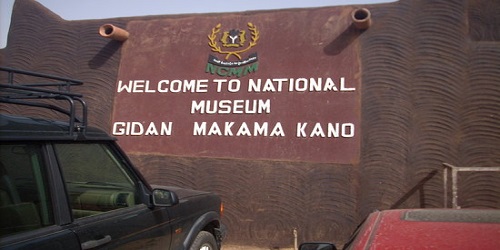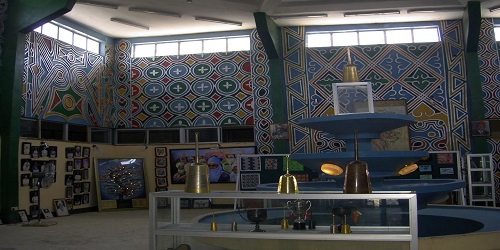
Located in the heart of the city, the house is believed to have been built in the 15th Century AD by the then emir of Kano Abdullahi Burja for his grandson Rumfa. It was said that Burja decided to reward his grandson’s show of bravery by building the house for him.It became Gidan Makama when the emir appointed Rumfa as the Makaman Kano. Rumfa lived in the house while he was Makama and also when he eventually became the emir of Kano. He was living in the house when he decided to build the present emir’s palace, and he relocated to the new palace on completion.A visit to Kano’s famous museum reveals its delightful history, memorable gallaries — and numerous challenges. One of the best known historical buildings in Kano, that had once served as a temporary palace of the emir before it now houses the city’s collections of arts, crafts and other historical materials, is Gidan Makama (the house of Makama). The building, turned into a museum, appropriately called Gidan Makama Museum, is attracting tourists to Kano city on account of its excellent architectural design and the priceless collections it holds.
As one enters the gate that leads to the museum, the sight of some gigantic pots on the outer premises of the museum welcomes the visitor. The pots are so big that a grown up person can enter into one and sit comfortably. The pots are said to have been excavated at the Kofar Kabuga, one of the gates around Kano city wall (ganuwa) through which the colonial masters entered and conquered Kano. There are various explanations as to the use of these pots, but a popular tradition states that they were buried along the city-walls by Kano kings for protection in the olden days.Other exhibits at the entrance of the museum are two cannons which, according to Yerima, were abandoned by the colonial masters when they conquered Kano. They are believed to have been part of the arsenal with which the British conquered Kano in 1903. One is for long range shots while the other is for short range shots. Four of such cannons were discovered at a military barrack at Bompai area of the city but only two were deposited at the museum.The Gidan Makama building is partitioned into nine galleries (each called zaure), with each gallery showcasing a particular aspect of the ancient Kanawa (people of Kano) life. Zaure is the main entrance of a typical Hausa building. Explaining what is exhibited in the first gallery, Yerima said they are items related to building materials of the ancient Kano. It is with these materials that the Gidan Makama was built. They include makuba, a kind of soil additive used as cement and paint by the ancient Kano people. There is azara, palm trees used for thatching roofs, and some other materials used for building. At the other side of the gallery is the olden day’s gate of Kofar Waika (one of the Kano City Gates). It is a very big iron gate, and attached to it is a metal slate with some Arabic inscriptions believed to be a charm for protection.
As one leaves the first gallery, on his way to the second one, there stand other big iron gates including the Kofar Kabuga gate through which the colonialists got into the city and conquered it in 1903. Also on display in this gallery is the map showing the Kano city walls, its original number and its expansion to the present 19 gates.The next gallery depicts the history of Kano city from its pagan period to the present day. A shrine of an idol called Tsumburbura could be seen on top of Dala hill with a picture of worshippers under the hill. The idol was under the care of the chief priest called Barbushe and under him are several lesser priests. It also gives the story of the earlier invaders of Kano land led by Bagauda, and how they conquered and imposed themselves on the ancient Kano people.On leaving this gallery, one is ushered into another where an illustration of the history of Kano in the 19th century is showcased. The structure of the Habe (non-Fulani) dynasty and the Fulani dynasty is shown. Next to this gallery is a place where the occupation of ancient Kano people is depicted. Exhibits of farm implements and hunting instruments are shown. Explaining the types of crops grown at that time, the technical officer said crops such as millet, sorghum, cowpea and groundnut were cultivated.The samples of war instruments such as iron and leather shield, sword and gun are exhibited in the next gallery. Yerima said the iron-made shield was donated to the emir of Kano by a German envoy. Next to it is the gallery showcasing the royal regalia. Here the royal shoes, staff, worn fan and turban are shown. Exhibits of musical instruments are showcased in the next gallery for fun seekers.

Immediately after this gallery, the pictures of Nigerian nationalists such as Nnamdi Azikiwe, Sardauna Ahmadu Bello, Tafawa Balewa, among others, are showcased, and alongside these are the pictures of some of the colonial masters in the next gallery.Darul Islam (House of Islam) is the next gallery. As the name suggests, the gallery is all about the Islamic heritage of the Kanawa. On display is the information about the pillars of Islam, astrology, a copy of a hand-written Qur’an, information about the Maliki school of thought, portrait of a Qur’anic teacher on a leather mat with the slate and ink bottle also displayed to show a typical Qur’anic school.From Darul Islam to the next gallery, there is an open space where activities for fun are performed. Durbar gallery is where pictures of Sallah durbar are shown. The pictures of the emir with different title holders on horsebacks are exhibited. Durbar, as it is called, is a four-day colourful event of spectacular parade of dancers and musical performers etc and display of horsemanship to mark the end of Ramadan fasting celebration (for eid-el-fitr) and the eid-el-kabir.
The last gallery in the Gidan Makama Museum is the bride’s room. This gallery is about traditional Hausa bride’s room. Exhibits in the room are tasa, a kind of bronze dish; taskira, a bowl made of palm leaves used for keeping cotton spinning items; tukurwa bed, made from palm trunk; calabashes, grinding stones and water containers, among others.The museum is visited by many people for varied reasons. While some go there to see the exhibits in the house, others go for cultural activities that are being organised. Children and women constitute the majority of this group. Though the house is open for the whole week, higher number of people visiting is recorded during Sallah festival.




